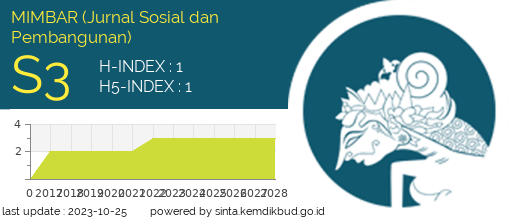Community Empowerment Strategy In Muntigunung Village, Indonesia
DOI:
https://doi.org/10.29313/mimbar.vi.2484Keywords:
Community, Empowerment, StrategyAbstract
This article examines community empowerment strategies in Muntigunung village, which is the poorest village in Bali. To alleviate the basic problems faced by local communities, the Muntigunung Environmental Development Program was developed with a special focus on the air, economic, health and education sectors. With the aim of improving the economy and creating productive jobs, products were developed from natural resources that already exist in Muntigunung, such as cashew nuts and palm sugar. This was then continued with the development of new products made from rosella, mango and moringa. The aim of this research is to determine the empirical problems that occur. The author emphasizes the role of the Company in empowering the community in Muntigunung village in terms of the forms and obstacles in carrying out its activities. The method in this research is a qualitative method to produce descriptive data, both in the form of written and verbal expressions from people and observed behavior. The author also intends to understand the meaning contained so that he can find the essence conveyed in this empowerment. It is hoped that this essence can find sources of prosperity contained in the community empowerment strategy in improving welfare in Muntigunung Village. The community empowerment strategy in Muntigunung Village has brought significant changes in various aspects of community life. Economic development, improving education and health, infrastructure development, as well as women's empowerment and environmental conservation are some of the areas that have experienced improvement. This success shows that with the right approach, community empowerment can create sustainable change and improve the overall quality of life.
References
Ansori. (2015). Pemberdayaan Masyarakat Miskin Melalui Usaha Mikro Kecil Dan Menengah (Umkm). Paper Knowledge . Toward a Media History of Documents, 3(April), 49–58.
Aryan Torrido. (2023). Effective Leadership and Social Entrepreneurship Engagement in Optimal MSMEs Performance. MIMBAR : Jurnal Sosial Dan Pembangunan, 79, 257–264. https://doi.org/10.29313/mimbar.vi.2076
Empowerment, C. (2024). Revitalization of thematic villages through red ginger cultivation in Mulyorejo Village, Malang City. 9(5), 821–833.
Erwidodo. (1999). Modernisasi dan Penguatan Ekonomi Masyarakat Perdesaan dalam Pembangunan Ekonomi Rakyat di Pedesaan: Sebagai Strategi Penanggulangan Kemiskinan. PT. Bina Rena Pariwara.
Fadilah, A. A. (2020). Pemberdayaan Masyarakat Berbasis Ekonomi Mikro Melalui Peran. Community Development: Jurnal Pengambangan Masyarakat Islam, 04(2), 175–178.
Fitrianesti, R., & Muhtadi, M. (2022). Pemberdayaan Masyarakat Melalui Program Pelatihan Keterampilan dalam Membangun Kemandirian di Yayasan Inspirasi Indonesia Membangun (YIIM) Jakarta Selatan. Jurnal Pemberdayaan Masyarakat, 10(1), 23. https://doi.org/10.37064/jpm.v10i1.9883
Fitriani, A., Malkab, A. H., & Ikayanti, D. (2024). Pelatihan Dan Pemberdayaan Masyarakat Dalam Pembuatan Lulur Tradisional ( Bedda Lotong ) Di Kelurahan Lappa Kabupaten Sinjai. 5(2), 1–8. https://doi.org/10.55314/jcoment.v5i2.750
Hanis, N. W., & Marzaman, A. (2020). Peran Pemberdayaan Kesejahteraan Keluarga dalam Pemberdayaan Perempuan di Kecamatan Telaga. Publik (Jurnal Ilmu Administrasi), 8(2), 123. https://doi.org/10.31314/pjia.8.2.123-135.2019
Ibrahim, H. R. (2022). Pemberdayaan Usaha Mikro Kecil Menengah Melalui Pendekatan Inovasi Sosial Dan Collaborative Governance. Jurnal Ilmu Dan Budaya, 43(1), 103–116.
Indrayani, D. &. (2016). Pegantar Sosiologi Perdesaan. Kencana.
Kuburaya, K., Kalimantan, P., & Rahman, A. (1945). IDENTIFIKASI STRATEGI PENINGKATAN KESEJAHTERAAN MASYARAKAT DI KECAMATAN SUNGAIAMBAWANG KABUPATEN Kuburaya PROVINSI KALIMANTAN BARAT. 17–36.
Malang, U. N. (2022). KEMISKINAN DAN PERUBAHAN SOSIAL : SEBUAH MODEL TRANSFORMASI. 11(3), 572–579.
Malta. (2023). The Concept of Strategy in Community Empowerment: A Literature Review. Influence: International Journal of Science Review, 5(3), 24–34. https://doi.org/10.54783/influencejournal.v5i3.179
Martono, N. (2014). Sosiologi Perubahan Sosial “Perspektif Klasik, Modern, Posmodern, dan Poskolonial.” PT. RajaGrafindo Persada.
Maspaitella, M. J., & Rahakbauwi, N. (2014). Pembangunan Kesejahteraan Sosial: Pemberdayaan Masyarakat Dalam Pendekatan Pekerja Sosial. Aspirasi, 5(2), 157–164. https://jurnal.dpr.go.id/index.php/aspirasi/article/view/457/354
Moleong, L. J. (2017). Metode Penelitian Kualitatif. Remaja Rosdakarya.
Otaya, L. G., Tjabolo, S. A., & Husain, R. T. (2019). Analisis kebutuhan pemberdayaan ibu rumah tangga miskin melalui usaha kerajinan tangan khas Gorontalo “Mohalamu Tiohu.” JPPM (Jurnal Pendidikan Dan Pemberdayaan Masyarakat), 6(1), 59–75. https://doi.org/10.21831/jppm.v6i1.21736
Priatna, I. A., & Hakim, D. (2023). Influence of Internal and External Business Factors on the Income of BUMDes in Bogor Regency. 10, 158–165.
Psikologi, P. S., Psikologi, F., Al, U., Indonesia, A., Kompleks, S., Agung, M., & Azhar, A. (2015). Pengaruh Etos Kerja Terhadap Kinerja Karyawan PT. AE. 2, 150–158.
Purworini, D., Surakarta, U. M., Purworini, D., Rizkhy, R., Chasana, B., Palupi, P., & Setyawan, S. (2023). The Role of Community Empowerment in the Development of a Marketing Communication Strategy for Kembang Kuning Tourism Village. ASEAN Journal of Community Engagement, 7(1), 113–126. https://doi.org/10.7454/ajce.v7i7.1193
Rusli, Z., Yuliani, F., Sulistianingsih, E., & Sadad, A. (2012). Pemberdayaan Masyarakat Miskin Melalui Program Usaha Ekonomi Desa-Simpan Pinjam (UED-SP). Jurnal Kebijakan Publik, 3(2), 59–141.
Sule, E.T., & Priansa., D. J. (2018). Kepemimpinan dan Perilaku Organisasi. (Membangun Organisasi Unggul di Era Perubahan). PT. Refika.
Sumodiningrat, G. (1996). Memberdayakan Masyarakat: Kumpulan Makalah Mengenai Inpres Desa Tertinggal. Penakencana.
Sutrisno, E. (2017). Manajemen Sumber Daya Manusia. Kencana Prenadamedia Group.
Sztompka, P. (2014). Sosiologi Perubahan Sosial. Prenada.
Tanzil, T. (2018). Community Empowerment Strategy Based on Social and Cultural Capital of Coastal Communities at Makassar Island. IOP Conference Series: Earth and Environmental Science, 156(1), 0–4. https://doi.org/10.1088/1755-1315/156/1/012052
Tarlani, T., Dariah, A. R., & Nurdin. (2023). Development of Tourist Destination on Regional Through Village Own Enterprise ( BUMDES ) Empowerment. MIMBAR : Jurnal Sosial Dan Pembangunan, 39(1), 166–176. https://journals.unisba.ac.id/index.php/mimbar/article/view/2228.
Downloads
Published
Issue
Section
License
Copyright (c) 2024 Mutria Farhaeni, Lisnawati Guntar Elsita, Martini Sri

This work is licensed under a Creative Commons Attribution-NonCommercial-ShareAlike 4.0 International License.














